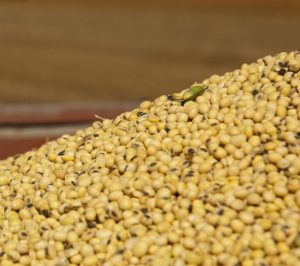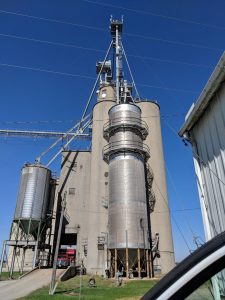Agronomy, Grain Marketing, Homepage Slider, Soybean Quality
Maintaining soybean quality after harvest
By Dusty Sonnenberg, CCA, Ohio Field Leader
In the challenging spring of 2019, some first-crop soybeans were planted this year in a more traditional “double-crop” window of opportunity when looking at the calendar. The risk now is that the later planted beans may be killed by frost or a freeze before they reach physiological maturity and will not begin the dry down process like they would under normal conditions. The lower quality that can result is a concern this fall, particularly for food grade, seed or other specialty soybeans.
“You have got to harvest them clean,” said Bruce Wymer, vice president of food grade soybeans for Citizens Elevator.
It is generally recommended to harvest soybeans between 12% and 15% moisture. When soybeans are at or above 18% moisture, there is concern they can be damaged or crushed. Most newer rotor combines can effectively thresh soybeans up to 20% moisture. Soybeans that have not reached complete physiological maturity are more difficult to cleanly harvest, and a large number of pods end up in the grain tank.
The soybean quality cannot be improved once it is harvested and put in storage. If beans are not properly cleaned before entering the bin, the excess pods and weed seed can result in decreased air flow and circulation and lead to increased insect population and mold growth.
“Ideally the soybean plants mature and the beans dry in the field. That provides the best situation for clean harvesting of the crop. If they are killed by frost or a freeze, or if a herbicide is used as a harvest aid, then clean harvesting is more challenging,” Wymer said. “Ideally, a farmer can harvest the beans clean, dry them as necessary, cool the beans and put them in storage. You will never improve the quality of the soybean, only maintain it.”
The stakes are higher, though with specialty beans.
“If you need to mechanically dry the beans, depending on the specific market requirements, maintaining soybean quality while drying takes time and patience. Most grain companies are not as concerned about maintaining the soybean quality as they are about getting the soybeans dry for storage. Food grade beans and seed beans are a different story,” Wymer said. “The key to drying soybeans while maintaining quality is to use low heat and go slow. At Citizens, we will typically run the soybeans through the dryer before storage. We can take beans from 20% moisture and dry them and still maintain the quality we need. We keep the heat low — 90 degrees — so we do not crack the hulls, and then run them through the dryer. We will run them through the dryer twice if necessary. We have found that once we get above 100 degrees Fahrenheit, the hulls crack open, which is problematic for food grade soybeans.”
Proper drying and storage is a key to maintaining soybean quality and having a marketable crop. According to Ken Hellevang, an Agricultural Engineer at North Dakota State University Extension, there are several things to keep in mind when drying soybeans.
- If using natural air-dry flow, rate recommendations are to use an airflow rate of at least 1 cfm/bushel to natural air-dry up to 15% to 16% moisture soybeans.
- Start the fan when the outdoor temperature averages about 40 degrees F.

- Follow the manufacturer’s recommendation for high-temperature drying soybeans.
- Monitor the soybean quality and reduce the drying temperature if excessive cracking or splitting occurs.
- Reduce the fire hazard by keeping the soybeans flowing in the dryer. Pods and trash can become lodged and combustible.
- Frequently clean the dryer to remove anything that may impede flow. Constantly monitor the dryer when drying soybeans.
It is also important to ensure good ventilation when drying during cold temperatures. Check vents and exhausts for ice or frost to avoid damage to the roof. Leave the access door open to relive pressure when operating the fan at temperatures near or below freezing. Over drying can also be an issue. It’s important to not heat beans over 120 degrees Fahrenheit as high temperatures can cause damage to seed coats and lead to increased risk of the soybeans splitting. A study found temperatures of 130 degrees Fahrenheit caused 50% to 90% of seed coats to be cracked, increasing the amount of split beans to 20% to 70%. Soybean seed is softer than corn and more easily damaged by drying temperatures as well as augers or other handling equipment.
Some additional soybean storage recommendations from Iowa State University Extension include:
- Level off bins immediately after harvest.
- Avoid using worn augers and mechanical spreaders that will damage the seed while filling.
- Aerate the bin as soon as it is filled to remove the heat, regardless of the moisture.
- Aerate the stored soybeans to maintain grain temperature at 35 degrees to 40 degrees F in winter and 40 degrees to 60 degrees F in summer.
- Check bins every couple of weeks throughout the season for signs of crusting, aerate if needed.